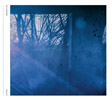 While many artists use the sonic medium as a canvas to paint imaginary journeys conceptually through sound and instrumentation, this Australian duo takes the concept to a more literal point by utilizing recordings of actual events and elements referenced in the track titles in addition to traditional instrumentation. The result is a wonderfully dark, post-rock tinged trip that shows the 12k label is at the cusp of more than just laptop programming and art installation sounds.
While many artists use the sonic medium as a canvas to paint imaginary journeys conceptually through sound and instrumentation, this Australian duo takes the concept to a more literal point by utilizing recordings of actual events and elements referenced in the track titles in addition to traditional instrumentation. The result is a wonderfully dark, post-rock tinged trip that shows the 12k label is at the cusp of more than just laptop programming and art installation sounds.
The opening "Ablation" uses the actual sounds of ice and wind to create a murky atmosphere that sounds like rattling engines and running water, never clearly identifiable at first, but familiar and organic. Later in the track some untreated cello and piano arise, starkly contrasting the "known" instruments with the "unknown" ambience. "Hydraulic Fluctuations" (based on fluid fluctuations recorded inside a large pump) has some more overt filtered water noises, but also a clattering percussive part that sounds like rocks rattling together, along with some deep, rich stringed instrument tones. The mix is thick and dense, and far from the minimalism one might expect.
"Canal Rocks" features a field recording of wind through a small rocky alcove in Australia, which is contrasted with a gentle, hovering melody. As the track goes on, the lighter moments are supplanted by the deeper, dense textures. "Beyond This Window" opens with shimmering feedback like tones and understated strings that focus more on the musical rather than environmental end of the sound spectrum, though the calming rush of a rainstorm keeps things rooted in nature.
The low end rumbles and echoed reverberations "In The Light Storming" uses obviously resemble a violent storm, the sound creeping into textures that have a vaguely early industrial vibe to them. However, the sound is never oppressively dark or violent, and instead the sun shines through at the end to reveal bits of pure, untouched ambience. "Look For Me Here" (also available as a CD single with remixes by Ryuichi Sakamoto and Giuseppe Ielasi) is the closest thing to being overt "post-rock" with its distant pings and pulses, rattling fuzz and swells of orchestral like tones. Glistening chimes and hammered guitar notes sit above of filtered noise that nicely compliments the more traditionally beautiful moments.
The final two tracks of this journey are much more dark and sinister than the rest. "Loom" is an appropriate title for a piece of humming ominous strings and dark, growling like textures. Cello, guitar and other strings provide a more familiar reference point to the otherwise murky mire, but even they alternate between a melancholy drone and a violent, panicked pace. The long closer, "Woods Flesh Bone," is another literally titled track. Consisting of field recordings that can only be described as "wet," the sound is amplified by flies buzzing all around (based on field recordings of a chicken carcass), and an eerie calm, punctuated by birds far away. The sound of dark isolation grows worse as the synthetic elements become more pronounced as the track winds down, leading to a dark, bleak foreboding sound that is one of the best examples of how to aurally represent decay. Rather than the journey ending happily, it instead finishes on a bleak, sinister note.
Each piece functions on its own as a microcosm of organic sound although all are thematically linked, expertly mixing untouched field recordings, treated sounds, and traditional instrumentation into a work that sounds decidedly natural, yet completely mysterious. It is the kind of album that begs to be replayed not just because of its inherent strength, but also because of its variation and complexity.
samples:
Read More

